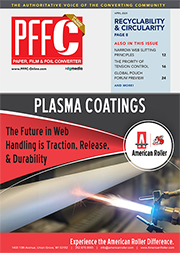Featured Stories
-
Tension: The First Thing We Must Get Right
Web tension is arguably the most important parameter for any web process. Tension is the first thing we must get right. -
Principles of Narrow Web Slitting
For those veterans in the slitting-winding community, this commentary is not necessarily new information, but reviews are always good too. -
Recyclability & Circularity Consumers Support Sustainable Brand Packaging
Sustainability has never been more central for the printing and packaging industries.
News | New Products
-
Hong Kong PrintPack Fairs Open in April
Jointly organized by the Hong Kong Trade Development Council and CIEC Exhibition Company (HK) Limited, the two PrintPack Fairs will be April 27-30, 2024 at AsiaWorld-Expo
-
BioEmitter®- Keeping Corrosion and Rust at Bay in Enclosed Spaces
One of the most important missions of Cortec® Corporation, a global leader in the corrosion protection industry, is environmental responsibility.
-
Fedrigoni Names New Commercial Senior Vice President, Chief Marketing Officer
Fedrigoni — the world’s leading manufacturer of specialty papers, premium self-adhesive materials, RFID and connected solutions
-
SEI integrates Vetaphone on new Labelmaster KyoJet
SEI Laser Converting is based in Buja in the northeast corner of Italy.
-
Former Division of the Knox Woolen Mill in Camden Acquired
Edward H. Best Company has been acquired by Windward Ventures LLC, a Maine-based investment group.
-
Miraclon and BOBST reinforce strategic partnership
Miraclon and BOBST have reinforced their strategic partnership, with Miraclon named as the plate technology partner in BOBST’s new Competence Center in Atlanta.
-
Anderson & Vreeland announces the expanded role of Tyler Thomas as National Sales Manager - U.S.
Anderson & Vreeland, a prominent manufacturer and distributor of flexographic print technologies, equipment, and consumables, is pleased to announce the expanded role of Tyler Thomas as National Sales Manager - U.S.
Expert Advice
Tracking Wrinkles: Part I
- Published: May 01, 2004, By Timothy J. Walker TJWalker & Assoc. Inc.
When traffic is heavy on a multi-lane freeway, staying in your lane is critical. We trust the other drivers in the cars next to us will stay in their lanes. The evenness of the road and the driver-controlled alignment of the tires promote parallel flow. If the cars on either side of you diverge, there is no problem. But if they begin to converge — look out. A fender bender is imminent.
Think about your web similarly. Imagine the wide web as a series of strips. We trust each strip of the web will stay in its lane. The uniform tension and dimensions of the web and straightness and alignment of the rollers promote parallel flow. If the strips diverge or spread, no problem. But if the strips converge — look out. A web bender or wrinkle is imminent.
What makes a web move off track or shift lanes? This concept is crucial in understanding web behavior, both good and bad. I would like to be able to give you a short, simple statement to answer this question, but I can't. I've heard some say “the web moves to the tight side.” Do not listen to them; this is an oversimplification.
There are three primary mechanisms that can cause a web to shift laterally: roller misalignment, roller diameter variations, and web bagginess.
Any of these tracking mechanisms can create a web wrinkle. If the entire web tracks too far to one side, it will create a shear wrinkle. If both sides of the web track to the center, it will create a tracking wrinkle. It is the tracking wrinkle I will emphasize in this and next month's columns.
Misalignment tracking is dependent on the parallel entry rule (see PFFC “Web Lines,” August and September 2003). The displacement of the web bonded by traction to a roller controls the bending of the upstream web span. With good traction, the web angle entering a roller will align parallel to the roller's surface motion.
Misalignment tracking occurs any time the web or roller angle differs from machine direction. Straight webs on straight and aligned rollers will have minimal lateral motion or position changes. If either the roller or web angles are shifted, the web will track to resolve the angle differences.
Roller bending is the most common source of tracking wrinkles. A bent roller has a consistent diameter but a continuously changing angle of rotation across its width, similar to a bowed anti-wrinkle roller. When the bowed roller is oriented pointing downstream, it is a powerful spreader. However, if the bow orientation points upstream, it is an equally powerful wrinkler.
Though a bowed roller should never be installed backward intentionally, there are several common conditions that create this undesired orientation. When a roller's length-to-diameter ratio is high, like a noodle, the roller may have excessive deflection due to gravity. Approaching a sagging roller from above will create a tracking wrinkle.
Noodle-like rollers also will deflect due to web tension. Tension-deflected rollers and large wrap angles align to create tracking wrinkles. Even the stockiest roller may see significant bending when end-loaded as a nip roller. Again, if the entry span is oriented parallel to the bending, the nip deflection will create tracking wrinkles.
The more mysterious misalignment wrinkles are created by the web. Extremely subtle angle errors in the web on perfectly aligned and cylindrical rollers will create tracking wrinkles. Web angle errors are created by web width expansion effects, usually due to heat, moisture, or tension changes. As a foil or film enters a roller-supported oven, the heating process will cause thermal expansion in the initial web spans.
Looking at either web edge, the web's angle will be slightly outward. As this outward angle approaches an aligned roller, the web and roller angles will disagree, causing each edge to move inward, forming a tracking wrinkle. The same effect occurs in moisturizing dry paper or necking recovery of a web moving from high to low tension.
Next month we will stay onboard the tracking wrinkle express, covering the important issues of web-roller traction, diameter variations, and web bagginess.

Timothy J. Walker has 20+ years of experience in web handling processes. He specializes in web handling education, process development, and production problem solving. Contact him at 404/373-3771; This email address is being protected from spambots. You need JavaScript enabled to view it.; tjwa.com.













